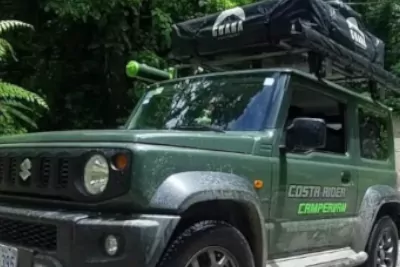To discover Costa Rica, it is essential to have a car. The size of the country allows going around without having to take a plane or a train which is why I think it is important to talk about the driving in Costa Rica.
Road conditions
I go straight to the point, most of the roads in Costa Rica are bad. Before driving, the most important thing is to have the vehicle adapted to the roads that you will take. Our Camper vans and 4×4 are made with vans used by the Costarican for school and tourist transports in all regions of the country, making it a reliable vehicle to use all the roads of the country.
On some roads, such as the one that allows you to reach the Monteverde region (which alternates between tracks and pieces of the road) or the road between Tamarindo and Montezuma along the Pacific coast, the traffic can be complicated with any car, and the use of a 100% adapted vehicle like our vans is essential.
Moreover, Costa Rica is crossed by many rivers that can see their levels greatly change between the rainy season and the dry season. During the dry season, most rivers are crossable using our vehicles, however, during the rainy season some rivers may become too high to be cross for all vehicles. They can be closed to traffic as the road between Samara and Montezuma or for going to Drake which is crossed by three rivers. No worries, there are still secondary roads. The best advice I can give you to cross a watercourse in Costa Rica is, if the assessment of its level is not possible, to wait to see if an inhabitant of the region crosses this river or if it takes another route then you will follow him to reach your destination.
Finally, let’s talk about night driving. Generally, badly maintained roads are not or are very seldom illuminated at night. The low night-time lighting and the bad road conditions are factors that cannot recommend night driving in Costa Rica.
Traffic rules in Costa Rica
The purpose of this paragraph is not to detail all rules of the Tico traffic, but first, it would like to give you the advice to adopt the right actions in the event of an accident, and in the second time it will inform you about the risks that you will take in case of infractions.
The most important point in case of an accident is not to move the car. Do not hesitate to block traffic, people are used to it and will not hold you against it. Indeed, if you move the vehicle, insurance will not cover you and you will be immediately considered wrong. Then you have to call the police on 9.1.1 who will make the report. You will also call insurance which will send an agent on-site and will give you a statement number. A very complicated step, no? If you rent one of our Camper vans and 4×4 you will just have to call us and we will take care of all the necessary steps for you.
Let’s move on now about the infractions and the risks you will incur. Here, alcohol and narcotics, it is zero tolerance. In case of accident or control you will immediately be guilty and insurance no longer cover. The second important point to respect when you drive in Costa Rica is not to cross a double yellow line, the fine rises between 600 and 700 $! Finally, wearing a seatbelt is mandatory.
Let’s talk about speed now. In Costa Rica you have to drive at 25 km/hour in the school zone, 40 km/h in the city, between 60 and 80 km/h on the majority of roads, and 90 km/h as the maximum on the highway. The police do not stop for small speeding but if you get stopped for a high speeding fine prices are very important between $ 100 and $ 400. The last offense to avoid if you do not want to pay the high price is the use of the phone while driving. otherwise, you will have to pay between $ 500 and $ 600.
I think you are now ready to take the roads of Costa Rica driving one of our vans. Then you can enjoy the diversity of landscapes that offer the country while being free to come and go safely.
Ready for driving here in Costa Rica en explore the country in your campervan? Visit our main page for more info about renting one of our vehicles.

